Emma Jameson – 17 August, 2014
RendeRED demonstrates the power that can be sourced in the particularities of the exhibition space and how this can be explored and reworked so as to reinvigorate works with evocative meaning and striking visual effects. In its deviation from the ‘white cube', the Basement is a dynamic exhibition space in which art works can be incorporated within the Auckland cultural scene, adding another dimension to this social sphere and in turn being enriched by its vibrant, interactive atmosphere.
Auckland
RendeRED: An exhibition of works from The James Wallace Arts Trust
Curated by Tim Vickers
5 August - 31 October 2014
Red protects itself. No colour is as territorial. It stakes a claim, is on the alert against the spectrum - Derek Jarman.
The directive impact of the gallery space on the reception and interpretation of art objects is tested in Tim Vickers’ curated show RendeRED at the Basement theatre. In deviating from the gallery norm of the ‘white cube’, Vickers’ curated exhibition is an exploration into how colour can be utilised as a subjective element to create new connotative meaning and reveal different textural and tonal qualities within the aesthetic object.
RendeRED is part of an exciting collaborative project between the Basement and the James Wallace Arts Trust. It allows young curators to test and develop their skills by designing an exhibition concept that utilises works from the Trust’s collection and incorporating them into the unique environment of the Basement theatre. This revolving project is exciting, not only in its fostering of emerging curatorial talent, but also in its showcasing of ways in which art works can be rejuvenated by new creative perspectives - by being transported from the environment of a heritage house to the dynamic atmosphere of a busy inner-city theatre’s bar and foyer area. In such projects, the curator is faced with the challenge of not only presenting a thematically cohesive exhibition, but also ensuring that it is appropriate to the new environment in which it is displayed, taking into account the different audiences who might be encountering the works (either through active engagement or passive observance).
Vickers has adeptly considered both concerns. His resulting exhibition is thoughtful and dynamic in its selection of art of different media and styles. Through looking at the various works, the viewer’s eye is entertained and captivated perceptually and cognitively, through the organic appreciation of different aesthetic elements and the construction of various narrative scenarios.
The imaginative agency of the viewer is given free rein in the first work of the show, Andrew Topp’s Oi! (Let the Penny Drop). The rich red walls of the Basement theatre not only emphasise the dynamic contrast between the cool and warm blues that dominate the picture plane, but also pervade the painting’s narrative with a menacing and violent undertone. At the edge of the red block of colour is a small figure that seems to be clinging onto a wall hanging over the ocean that we can see in the background. The likely success of this figure being able to solicit help from the group of figures on the left of the picture plane seems unlikely. Although the presence of the dogs could suggest a search party, the dominating red tones create a sense of anxiety and danger, prompting the viewer to infer that the figure has been chased and forced off the side of the cliff.
I experienced a similar sense of ominous foreboding when looking at Ben Webb’s Monoprint. As well as providing a striking contrast against the muted grey, white and black tones of the print, the red background also encases the work with a theme of implied violence and suffering. This is perhaps appropriate for the work, as Webb frequently sources his imagery from portraits of people taken in Germany in the years immediately preceding World War II. The sense of melancholic nostalgia that usually infuses his works is thus given an additional and forceful dimension by the very nature of the background against which it is shown. The red background prompted me to immediately think of photographs of war prisoners or civilians who had become entangled in the unsettling chaos of conflict. Within such a viewing environment, then, the gaze of the man of the print becomes evocatively haunting, hinting at a trauma or loss that we cannot define.
However these narrative readings are purely subjective and are the result of my personal interpretation of the colour red. As exemplified in the exhibition notes, connotative readings of colours are culturally constructed and are fluid in nature. What I read from these artworks was probably vastly different from the meaning gained by the person next to me and it was this pure, unabashed celebration of the subjective viewing experience that I found so refreshing and invigorating in this exhibition.
I was particularly entranced by the way in which the red background served to highlight certain aesthetic qualities that placed the works in a relationship of reciprocal influence. In Peter Roche’s Untitled (from the Bloodline series) the dribbling passages of red are accentuated to almost seem like blood oozing from the incisions made into the black glass. The illuminated square of Trish Campbell’s Bask reflected and projected the red from its neighbouring walls onto the bricks against which it was displayed, enlivening the stone with an atmospheric rose-coloured aura.
This aura extended to Angus de Lange’s Painting No. 2694, its diluted tonal essences illuminating the gestural strokes of red paint at the side and within the middle of the painted canvas, placing them in striking contrast to the green and blue tones layered across the work. Against the walls and the luminosity of Bask, these red tones assumed a fiery quality and were emboldened with a swirling vitality that rendered the viewing process relentlessly active and enriching.
The effectiveness of this aesthetic interaction displays the consideration with which Vickers evidently planned this exhibition in order to maximise the visual qualities of different media and styles and produce a diverse range of impressive effects. RendeRED demonstrates the power that can be sourced in the particularities of the exhibition space and how this can be explored and reworked so as to reinvigorate works with evocative meaning and striking visual effects. In its deviation from the ‘white cube’, the Basement is a dynamic exhibition space in which art works can be incorporated within the Auckland cultural scene, adding another dimension to this social sphere and in turn being enriched by its vibrant, interactive atmosphere.
Emma Jameson is the 2014 EyeContact Artists Alliance Writing Intern, a programme made possible with generous funding from the ASB Community Trust.
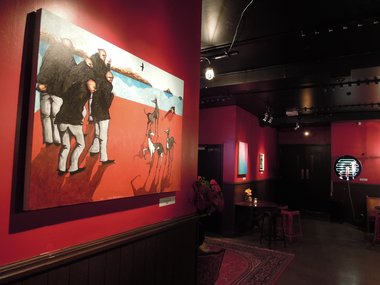

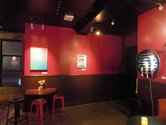
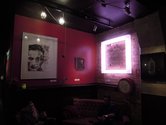

 Advertising in this column
Advertising in this column Two Rooms presents a program of residencies and projects
Two Rooms presents a program of residencies and projects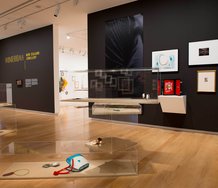
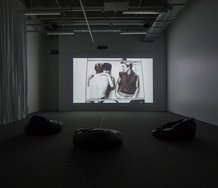


This Discussion has 0 comments.
Comment
Participate
Register to Participate.
Sign in
Sign in to an existing account.